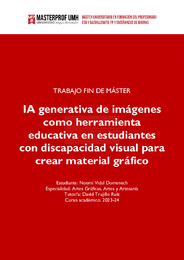Please use this identifier to cite or link to this item:
https://hdl.handle.net/11000/32690Full metadata record
| DC Field | Value | Language |
|---|---|---|
| dc.contributor.advisor | Trujillo, David | - |
| dc.contributor.author | Vidal Domenech, Noemí | - |
| dc.contributor.other | Departamentos de la UMH::Ciencias Sociales y Humanas | es_ES |
| dc.date.accessioned | 2024-07-24T11:04:02Z | - |
| dc.date.available | 2024-07-24T11:04:02Z | - |
| dc.date.created | 2024 | - |
| dc.identifier.uri | https://hdl.handle.net/11000/32690 | - |
| dc.description | Especialidad: Artes gráficas, artes y artesanía | es_ES |
| dc.description.abstract | El trabajo final de máster realizado durante el curso 2023-24, investiga el uso de inteligencia artificial (IA) generativa de imágenes como una herramienta didáctica adicional para que alumnado con limitaciones visuales agudas o totales pueda crear material gráfico para sus trabajos educativos, promoviendo la mejora de la accesibilidad e inclusión en educación. Este trabajo explora cómo las tecnologías de IA permiten a este grupo de estudiantes diseñar de forma autónoma material gráfico, como portadas, imágenes y logos a través de texto, voz y braille, cumpliendo la condición de que estas tecnologías IA sean compatibles con tecnologías asistidas. Los resultados obtenidos a través de casos de estudios y del análisis de herramientas adaptativas de IA, reflejan que a pesar de que los estudiantes tienen la posibilidad de generar material gráfico, que antes no se les permitía, optan utilizar la IA para obtener descripciones e información de imágenes ya existentes. Las diversas conclusiones indican el potencial de la IA generativa de imágenes para mejorar la experiencia de aprendizaje y la autonomía en estudiantes con discapacidad visual, sugiriendo la necesidad de adaptaciones didácticas para ampliar su efecto en entornos académicos, abriendo vías para futuras investigaciones de educación inclusiva con tecnologías IA. | es_ES |
| dc.description.abstract | The final master's thesis, carried out during the 2023-24 academic year, investigates the use of image-generative artificial intelligence (AI) as an additional didactic tool for students with acute or total visual limitations to create graphic material for their educational work, promoting the improvement of accessibility and inclusion in education. This work explores how AI technologies allow this group of students to autonomously design graphic material, such as covers, images and logos through text, voice and braille, fulfilling the condition that these AI technologies are compatible with assistive technologies. The results obtained through case studies and the analysis of adaptive AI tools reflect that despite the fact that students have the possibility to generate graphic material, which they were not allowed to do before, they choose to use AI to obtain descriptions and information from existing images. The various findings indicate the potential of image-generative AI to enhance the learning experience and autonomy in students with visual impairment, suggesting the need for didactic adaptations to amplify its effect in academic settings, opening avenues for future research on inclusive education with AI technologies. | es_ES |
| dc.format | application/pdf | es_ES |
| dc.format.extent | 37 | es_ES |
| dc.language.iso | spa | es_ES |
| dc.publisher | Universidad Miguel Hernández de Elche | es_ES |
| dc.rights | info:eu-repo/semantics/openAccess | es_ES |
| dc.rights.uri | http://creativecommons.org/licenses/by-nc-nd/4.0/ | * |
| dc.subject | Discapacidad visual | es_ES |
| dc.subject | IA generativa de imágenes | es_ES |
| dc.subject | Educación inclusiva | es_ES |
| dc.subject.other | CDU::3 - Ciencias sociales::37 - Educación. Enseñanza. Formación. Tiempo libre | es_ES |
| dc.title | IA generativa de imágenes como herramienta educativa en estudiantes con discapacidad visual para crear material gráfico | es_ES |
| dc.type | info:eu-repo/semantics/masterThesis | es_ES |

View/Open:
VIDAL DOMENECH, NOEMI.pdf
2,34 MB
Adobe PDF
Share:
.png)
